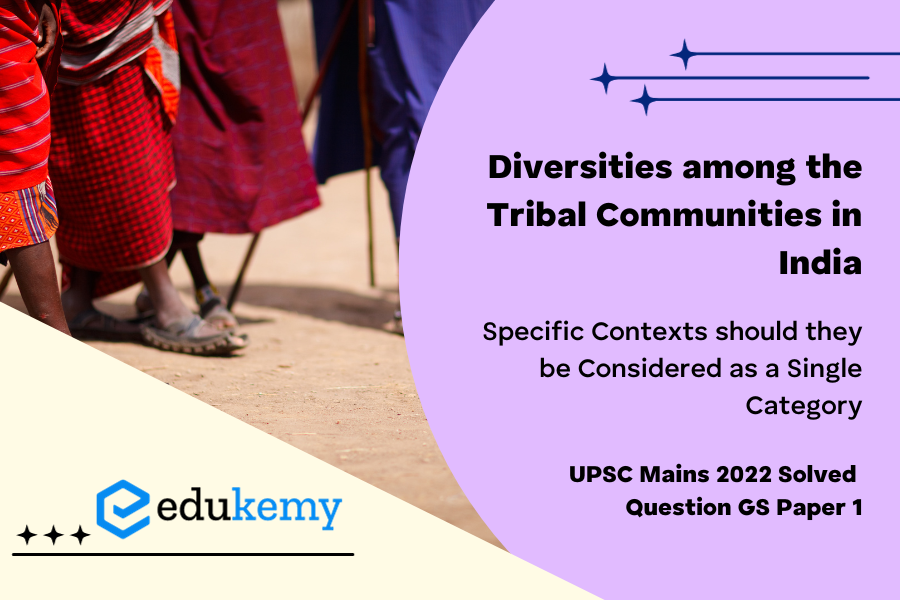While acknowledging the diversity among Tribal communities in India, certain contexts necessitate viewing them as a unified group. In policy formulation, addressing common challenges such as land alienation and cultural preservation is vital. Additionally, when advocating for their constitutional rights, recognizing their shared historical marginalization and socio-economic vulnerabilities is crucial for equitable development.
UPSC Mains General Studies Paper – 1 Mains 2022
UPSC Mains Civil Services IAS Exam Question Paper – 2022
Contents
Approach
- Start with explaining the Tribal communities in India.
- Discuss the diversity in the Tribal communities in India.
- Conclusion/ way forward to accordingly.
Answer
Introduction
Tribe is a social group having many clans, nomadic bands and other sub groups living on a definite geographical area having separate language, separate and singular culture. Government of India Act 1935 included members of the community living or dependent on the forest, in a single category called Scheduled Tribe (STs).
Body
Diversity in the Tribal communities in India:
Tribal communities in India are diverse and consist of a wide range of ethnic and linguistic groups. Tribal communities in India are a diverse group, with significant differences in terms of language, culture, and traditions. there are certain contexts in which it may be appropriate to consider them as a single category.

- Tribes in India : The total population of Scheduled Tribes is 10.43 crore as per the Census 2011 which accounts for 8.6 per cent of the country’s total population and 11.3 percent of the total rural population. The share of the Scheduled Tribe population in urban areas is a meagre 2.8%.Madhya Pradesh has the largest number of scheduled Tribes followed by Orissa. Bastar district of Chhattisgarh consists of the largest number of Scheduled Tribes. There are no Scheduled Tribes in Punjab, Delhi, Chandigarh, Pondicherry, Haryana.
- Geographical status of tribes: Roy Burman divides tribal communities into five territorial groupings, taking into account their historical ethnic and socio-cultural relations. These are :North-east India, comprising Assam, Arunachal Pradesh, Nagaland, Manipur and Tripura; The sub-Himalayan region of north and north-west India, comprising hill districts of Uttarakhand and Himachal Pradesh; Central and East India, Madhya Pradesh (Chhattisgarh),and Andhra Pradesh; South India comprising Tamil Nadu, Kerala and Karnataka; and Western India, comprising Rajasthan, Gujarat and Maharashtra.
- socio-economic condition of tribes: In tribal areas, most schools lack basic infrastructure, including minimal learning materials and even minimal sanitary provisions. Due to economic backwardness and insecure livelihood, the tribals face health problems. The degradation of the natural environment, particularly through the destruction of forests and a rapidly shrinking resource base, has its impact on the status of women. Increasingly, the traditional institutions and laws of tribals are coming into conflict with modern institutions which create apprehensions among the tribals about preserving their identity.
- Culture and language :Culture and Language of Major Tribes Unity in diversity is one of the most spectacular features amongst the population of India. Tribal culture of India, their traditions and practices interpenetrate almost all the aspects of Indian culture and civilisation. From the Aryan, Dravidian to the Indo-Tibetan languages, Indian tribal culture has also seen a tremendous merging of cultures within its own people.
- Education and sex ratio : According to the Census figures, the literacy rate for STs in India improved from 47.1 per cent in 2001 to 59 per cent in 2011. The sex ratio among Scheduled Tribes is 990 females per 1,000 males.
- Tribal Economy : The dominant economies of the tribes are: Hunting, Fishing and Gathering. Most of them are practising primitive occupations like Shifting Cultivation and Lumbering, Sedentary Cultivation and Animal husbandry.
- Representation in Legislatures and Panchayats: Under Article 330 and 332 of the Indian Constitution, seats have been reserved for Scheduled Tribes in Lok Sabha and state Vidhan Sabha’s. Following the introduction of Panchayati Raj, Suitable safeguards have been provided for proper representation of the members of the Scheduled Tribes by reserving seats for them in the Gram Panchayats, Block Panchayats, District Panchayats etc.
- Reservation in the Service: Government has made provisions for their adequate representation in the services. To facilitate their adequate representation certain concessions have been provided, such as: Exemption in age limits and Relaxation in the standard of suitability.
Conclusion
Overall, while it is important to recognize the diversity among tribal communities in India, there are certain contexts in which it may be appropriate to consider them as a single category, such as when addressing issues related to their overall socio-economic and political status and their relationship with the state and other non-tribal groups.
In case you still have your doubts, contact us on 8792740517.
For UPSC Prelims Resources, Click here
For Daily Updates and Study Material:
Join our Telegram Channel – Edukemy for IAS
- 1. Learn through Videos – here
- 2. Be Exam Ready by Practicing Daily MCQs – here
- 3. Daily Newsletter – Get all your Current Affairs Covered – here
- 4. Mains Answer Writing Practice – here


